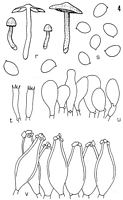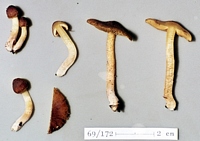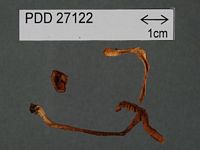|
 Inocybe cerea Inocybe cerea
BiostatusPresent in region - Indigenous. Endemic
Images (click to enlarge)
Caption: Inocybe cerea (type): r, carpophores;
s, spores; t, basidia; u, cheilocystidia; v, pleurocystidia. | 
Caption: 69/172: pdd 27165: Inocybe cerea
Owner: Egon Horak | 
Caption: Dried type specimen
Owner: Herb PDD |
Article: Horak, E. (1978) [1977]. Fungi Agaricini Novaezelandiae. VI. Inocybe (Fr.) Fr. and Astrosporina Schroeter. New Zealand Journal of Botany 15(4): 713–747 (http://www.rsnz.org/publish/abstracts.php).
Description: Pileus -30 mm diam., hemispherical becoming
convex to umbonate expanded; brown at disc, yellow-brown towards the margin,
in young carpophores margin densely covered with yellow strigose fibrils or
hairs, later washed off; dry, fibrillose, estriate. Lamellae adnexed or emarginate-adnate,
ventricose, crowded; light yellow turning yellow-brown; brownish fimbriate edges.
Stipe 20-45 x 3-4 mm, cylindrical, equal; yellowish turning wax-yellow or yellowish
brownish, with pink tints towards the base; upper half pruinate, with appressed
white fibrils towards base; dry, solid, veil remnants absent, single or grown
together. Context yellowish with greenish tints, white in base of stipe. Odour
acidulous, like Lepiota cristata. Spores 6-7 x 4.5-5 µm, ovoid, smooth, brown.
Basidia 18-26 x 7 µm, 4-spored. Cheilocystidia 15-35 x 10-18 µm, clavate to
vesicular, thin-walled, hyaline, not encrusted. Pleurocystidia 35-50 x 13-8
µm, fusoid, thick-walled (-2 µm diam.), encrusted. Caulocystidia -100 x -12
µm, cylindrical to fusoid with a long neck, thin-walled, occasionally encrusted
with crystals, hyaline. Cuticle a cutis of cylindrical hyphae (5-10 µm diam.),
encrusted with yellow-brown pigment. Clamp connections numerous.
Habitat: On soil under Nothofagus
(N. cliffortioides, N. menziesii), Dacrydium, and Podocarpus.
New Zealand.
Notes: Several characters are specific for I.
cerea: they re the yellow colour of the fruiting bodies, in young specimens
yellow strigose hairs along margins of the pileus, the vesiculose cheilocystidia,
and the ovoid pores.
|